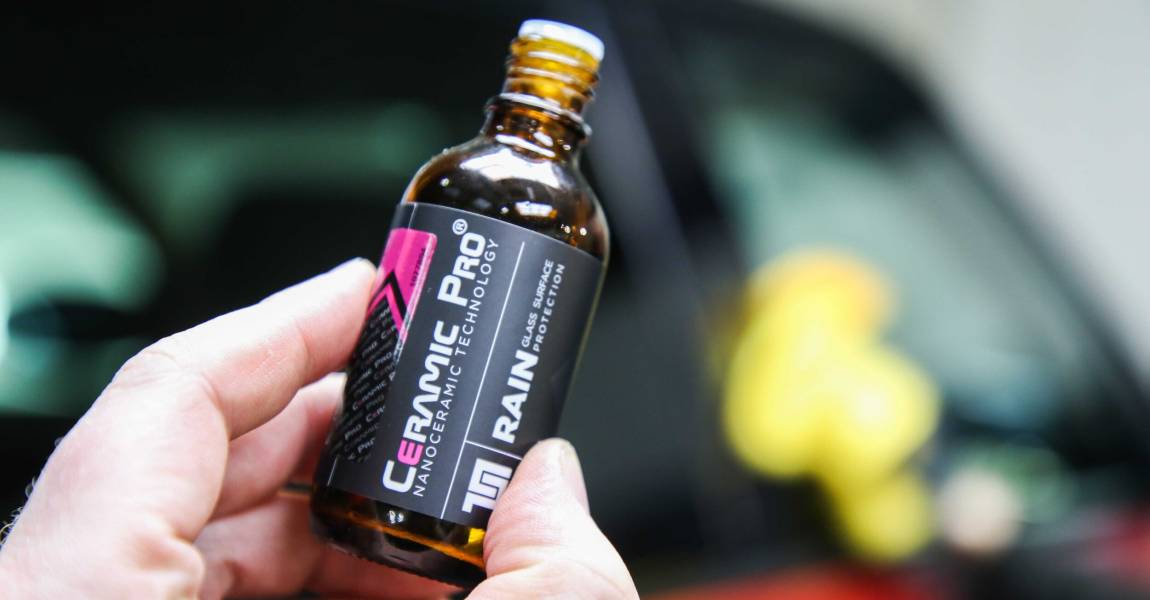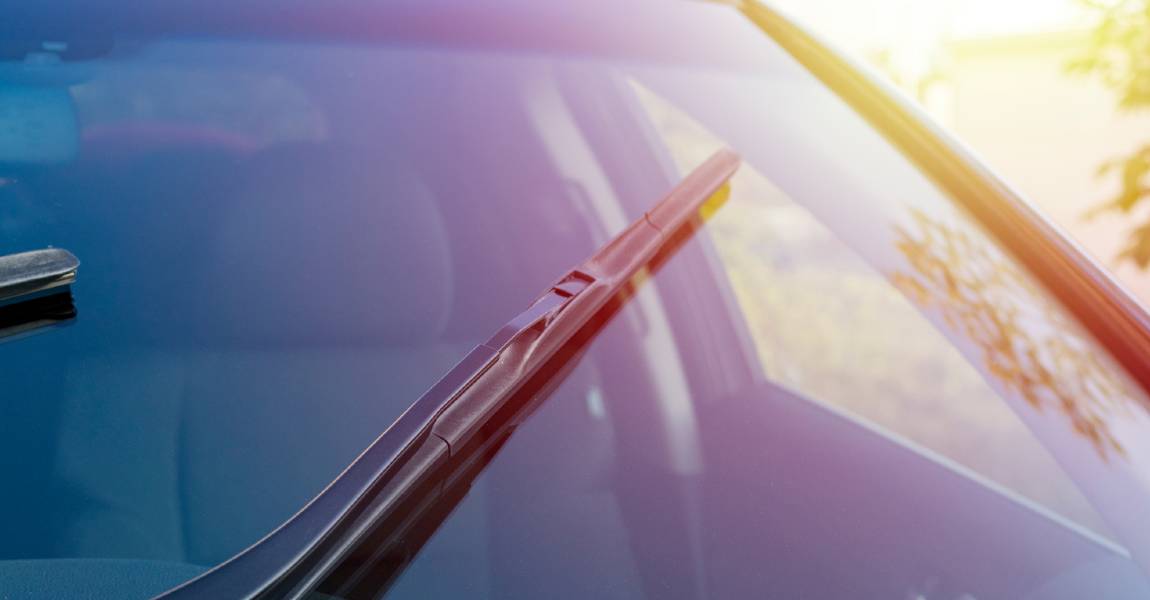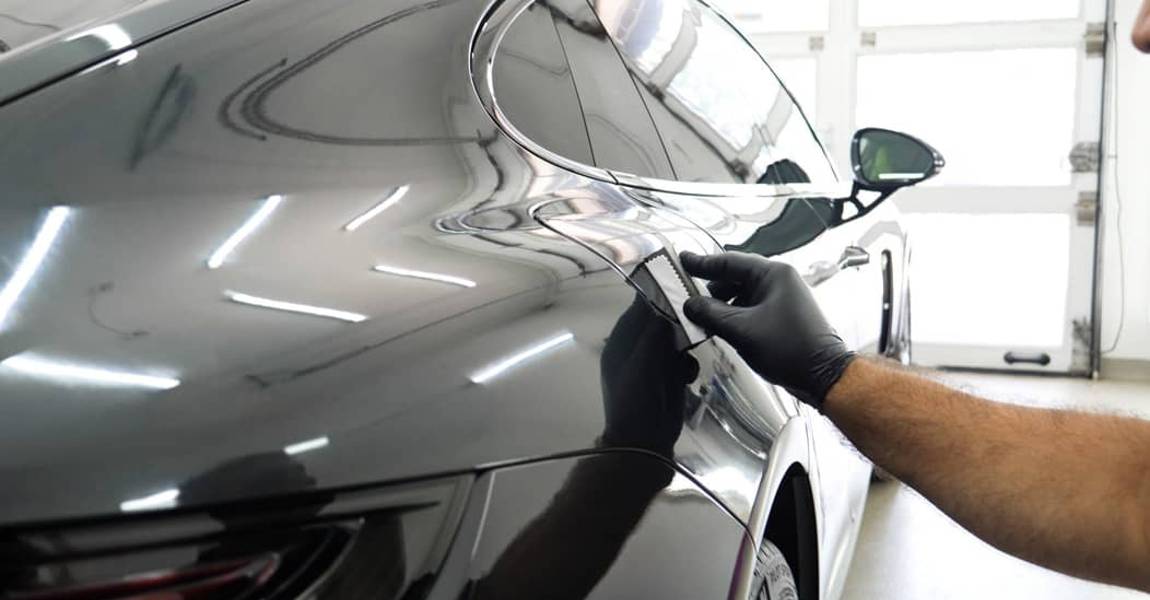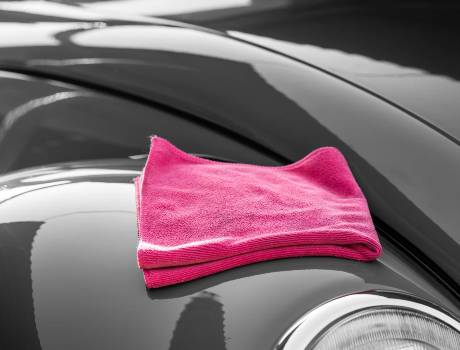Have you been wondering, “What is ceramic car coating?” Ceramic coating is a type of auto detailing product that offers a strong layer of protection against any damage-causing elements as an alternative to clear bra. It creates a hydrophobic layer composed of silica and titanium dioxide that form a covalent bond on top of the clear coat. This protective seal is impervious to dirt, most antifreeze, tree sap, UV rays, salt and water spots. The durability of the product can range from 1-3 years depending on the grade chosen.
High Grade ceramic coating provides an even greater level of protection with additional ingredients such as SiO2, Tio2, Zinc Oxide and more for added hydrophobicity, heat resistance and anti-corrosive properties. Not only does it add shine and clarity to the vehicle but also in some cases can correcting imperfections such as swirls or scratches all in one application. Proper application can dramatically increase your vehicles lifespan and make it easier to maintain its showroom look for many years to come.

Basics of Ceramic Car Coating
We all know how embarrassing it is to have a dirty, scratched or stained car. Washing it everyday and waxing it monthly doesn’t seem to help in the long run. This is where ceramic coatings come into play. With its advanced nanotechnology, a ceramic car coating generally lasts up to 8 years and provides maximum protection from contaminants like dirt grime, bird droppings, UV exposure and pollutants. The application of this advanced coating increases durability, scratch resistance and shine of the vehicle for months on end. It also reduces maintenance costs significantly by eliminating the need for frequent washing and waxing because all that’s now required is just rinsing and wiping it off with a soft cloth.
Ceramic coatings are virtually invisible once applied, but last much longer than gloss-based paint sealants or traditional waxes due to their semi-permanent bonded layer of protection. They don’t just look great; they are also environment-friendly since they reduce water consumption during washes by close to 50%. Therefore, instead of spending time and money every month on washing or applying a coat of wax your car, get an effective ceramic coating done that will make your prized possession look spotless throughout the year!
The Different Types of Ceramic Vehicle Coating
With regards to ceramic coatings for cars, the to options have come a long way since the days of a single professional-grade formula. From industry-leading products such as Ceramic Pro to more economical, DIY-friendly spray coatings, there is something for everyone when it comes to ceramic coating needs. This saturated segment is expanding as nano-technology and ceramic engineering continues to advance. These new formulations utilize microscopic particles that penetrate into the imperfections found in porous surfaces, which helps create an even application and bond with the surface beneath. Not only are traditional high-grade silicone dioxide or SiO2 (silicon dioxide) based coatings available on the market, but also carnauba wax products and Teflon-based spray coatings that are used to give cars some of the protective qualities as well as improved looks. These products provide significant advantages when it comes to protecting exposed surfaces from small scratches and blemishes that may occur over time due to environmental factors such as rain, sleet or snowfall. With several different types of ceramic coatings available today, consumers will have no problem finding something that meets their specific automobile protection needs without breaking the bank.
Check out our ceramic coating gallery for before and after photos.
Types of Ceramic Spray Coatings
Spray coatings have become a popular option in the automotive world due to their simplicity, durability, flexibility and cost effectiveness. There are numerous varieties of spray coatings on the market, from simple formulas that can be sprayed directly onto paint work, to more complex solutions containing ceramic elements for advanced protection.
- Teflon-based Sprays are the most rapidly evolving, giving an optically appealing finish as well as hydrophobic properties to protect against dirt, water and grime build-up. These do not contain the same ingredients one would find in Ceramic Pro paint protection products but provide results similarly.
- SiO2 Boost Sprays also known as Si02-base sprays, consist of a blend of 15-20% SiO2 and Titanium Dioxide (TiO2). This is applied to a vehicle’s paint surface and buffed off. The protection from UV radiation it provides is superior to that of carnauba wax, but it must be cured for 24-48 hours and should not be used as a long-term solution.
Nano Ceramic Coatings
Nano-ceramic coatings are revolutionary paint protection formulas that utilize nano-technology to create an extremely hard, ultra durable barrier between vehicle surfaces and the elements. Nano-coatings can be applied to a variety of materials, such as paint, glass, chrome, carbon fiber and vinyl or paint protection film, to reduce imperfections and improve the surface finish while providing protective capabilities. The hardness of this coating is measured using the pencil scale, with the highest rating being 9H. This designation signifies that the coating is as hard as quartz crystal, providing a great defense against chips, scratches, fading due to UV exposure and other damages inflicted by everyday environmental elements.
In addition to its strong protective capabilities, nano-ceramic coatings also provide beneficial aesthetic effects such as increased gloss levels enhanced color vibrancy on painted surfaces. Installation of this type of coating also keeps washing and maintenance times minimal since dirt will not be able to stick onto the exterior surface as easily as it would without it applied. If you’re looking for great car paint protection that lasts for years with minimal upkeep then nano-ceramic coatings are the perfect choice for your vehicle!
- DIY Nano Coatings-DIY ceramic coatings are available in varying strengths, ranging from 50 to 80 percent SiO2. These are designed for car owners to be able to apply them easily.
- Ceramic Pro Coatings-Ceramic Pro coatings are the top of the line in terms of ceramic coating technology and protection. Ceramic Pro formulations feature a combination of materials, including silica dioxide (SiO2) and titanium dioxide (TiO2). These elements bond together to create a hard, protective layer that offers superior protection against UV rays, dirt, dust, and other environmental contaminants. Additionally, Ceramic Pro coatings offer exceptional hydrophobicity, meaning they repel water and other liquids away from the surface. This makes it easier to keep your vehicle clean and shiny.

DIY Ceramic Car Coatings and Ceramic Pro
When it comes to coating a vehicle, there is a big difference between DIY ceramic coatings and professional grade ceramic pro. DIY solutions may offer a more affordable option, however, their results are variable quality. Ceramic Pro on the other hand offers an unprecedented level of control over prep work, adhesion, application and removal resulting in a protective layer that is far superior in terms strength and durability.
The use of nano particles give Ceramic Pro unparalleled protection against environmental stressors as well as UV damage. Additionally Ceramic Pro also offers hydrophobic properties that ensures dirt and grime build up is reduced further protecting your car’s paintwork from oxidation and other signs of age that come with regular washing. All this adds up to great looking cars with strong protection for years to come.
What’s The Difference Between Paint Protection Films And Ceramic Coatings?
Ceramic Coating Advantages & Benefits
A ceramic coating for cars is a perfect solution for anyone whose cars must withstand the usual wear and tear, as well as the damaging rays of the sun. It is composed of chemical compounds that are both permanent and easier to clean. There are many advantages to applying it on your car, such as protection from UV rays which can be detrimental to the paint job; it acts as a barrier, preventing oxidation, and paint swirls which results in fading and a dull look over time. Therefore, it is ideal for individuals who park their cars outside often. With air pollution rate only rising in cities, ceramic coating can add an extra layer of protection allowing more time between exterior detailing services.
In addition to UV ray protection, ceramic also prevent dirt build-up by providing an invisible shield against dirt and other contaminants that could damage your car’s exterior. The nano particles found in these coatings make them much more resistant to scratches and abrasions than regular paints or waxes; this extra layer of defense will help keep your car looking its best for longer. Furthermore, since ceramic coating is highly hydrophobic, water beads off its surface instead of sinking into cracks or scratches, thereby maintaining its luster.
What a Ceramic Paint Coating Can’t Do
When taking care of a car, a high-quality ceramic coating can be a great way to help protect the paint job and improve its overall appearance. It is important to note, however, that although ceramic coating makes your car look great with a glossy protective layer, it cannot actually prevent all types of scratches and swirl marks. Despite having excellent blending properties that protect against oxidation, your entire vehicle might still be at the receiving end of common scratches, swirl marks, and rock chips. Also, it will not eliminate the need to wash and maintain your car, as regular maintenance is still necessary to keep it looking its best.
It is important to remember that due to its paint-like characteristics, the ceramic coating will not stop any mechanical damage from occurring. For example, any heavy impacts or deep scratches inflicted on the body will make their way through the painted layers even if the car has been treated with a ceramic finish. To provide extra protection against this type of damage, it’s best to invest in protective film or vinyl wraps instead.
PPFs such as Kavaca do not have self-regenerative properties. However, some forms of PPFs with nano-technology can self-correct minor scratches in seconds, which is not achievable with a ceramic coating.

What Can Ceramic Coating be Applied to?
Ceramic coating can be applied to a variety of surfaces including metal, glass, plastic and even leather. It works as a protective barrier that is extremely resistant to scratches, UV rays, and abrasion. Metal surfaces are the most common ones to be treated due to their susceptibility to oxidation and rusting caused by environmental elements. They are also the most affected by acid rain, bird droppings, and other contaminates. Ceramic coatings can provide an extra layer of protection against these contaminants, making it easier to clean off the surface.
- Glass surfaces can be treated with a ceramic coating application as well. This type of coating acts as a dirt repellence and water, making it much easier to keep your car’s windows clean. Additionally, it also provides extra protection from UV rays, preventing the glass from fading or becoming discolored over time.
- Plastic and Leather-Ceramic coatings can also be applied to plastic and leather surfaces. It helps protect these materials from cracking, fading and staining due to exposure to UV rays and other environmental elements. Additionally, it creates a barrier between the surface and any oil, dirt or other contaminants that can build up over time. This makes it much easier to keep your car’s interior surfaces clean.
- Wheels & Calipers-Ceramic coating can also be applied to your car’s wheels and calipers. This will provide an extra layer of protection against brake dust, road grime and other contaminants that can build up over time. The nano particles found in ceramic coatings create a hard surface that is resistant to scratches and staining, helping to keep your wheels looking their best for longer. Additionally, this type of coating helps to reduce the need for frequent cleaning, making it easier to maintain your car’s wheels.
Ceramic coatings are an excelent way to protect and enhance the look of your car’s exterior and interior surfaces. Their hydrophobic properties help repel water, dirt and other contaminants, while their scratch-resistant qualities can help maintain your car looking its best for longer. Although ceramic coatings cannot prevent all types of scratches and paint swirl marks, they still provide an extra layer of protection that can help your car looking its best for years to come.
Applying a Ceramic Coating
Applying ceramic coating to your car requires patience, as it can be a time-consuming application process. To begin, you’ll need the ceramic coating kit and applicator cloth and sponge. Wrap the sponge with the cloth, as directed, then dab the cloth with the ceramic coating compound, again following directions for best results.
When working on your car’s paint, it is important to work in small sections and use a clean cloth as often as possible. Allow the compound to settle for 1-5 minutes in each area before moving on. As the coating evaporates from your car’s surface it will take on an “oil slick” shimmer effect known as “flashing.” Lastly, finish off each section by wiping it down with a clean microfiber towel.
With proper application of ceramic coating your vehicle will have remarkable gloss and protection that can last up to three years. Ceramic coatings bond onto surfaces chemically creating greatly increased levels of resistance to chemical etching due to dirt residue build up and other environmental factors. Furthermore this protective layer helps prevent light scratches, oxidation and fading caused by UV rays while simultaneously making regular cleaning easier by allowing water to simply bead off its surface. All these benefits combined make applying this protective layer a great way to keep your car looking its best.
Own a Tesla? Check out the article on Tesla Ceramic Coating Preparation

What Does it Cost for Ceramic Coating?
- Paint Costing Cost-The cost of ceramic coating can vary depending on the size of your vehicle and the number of coats being applied. Generally, a single coat covering an average-sized car can range from $500 to $1,500. For larger vehicles or multiple coats, the cost can be higher. It is important to remember that this is an investment in protecting your car’s paint job, so it is best to go with a reputable company that offers quality materials and services.
- Ceramic Glass Coating Cost– The cost of this type of coating can depend on the size of the vehicle and how many coats are applied. Generally, one coat for an average-sized car will range from $350 to $850. For larger vehicles or multiple coats, the cost may be higher. It is important to remember that this is an investment in protecting your car’s glass surfaces.
- Ceramic Wheel Coating Cost-The cost of ceramic wheel coating can also depend on the size of the vehicle and how many coats are applied. Typically, one coat for an average-sized car will range from $200 to $750. Larger vehicles or more coats may require a higher price.
- Ceramic Trim Coating Cost-The cost of ceramic trim coating will vary depending on the size of your vehicle and the number of coats applied. Generally, one coat for an average-sized car will range from $150 to $500. For larger vehicles or multiple coats, the cost may be higher. It is essential to consider that this would be an investment to preserve your vehicle’s trim, so it is advisable to select a reliable company that provides premium materials and services.
How Long Does it Take for a Ceramic-Coated Car to Cure?
The curing process of a ceramic-coated car usually takes between 12 and 24 hours. It is important to follow the manufacturer’s guidelines when it comes to curing the coating in order to ensure that the best results are achieved. After the coating has been applied, it needs to be left untouched for 12-24 hours in order for it to cure properly. During this period, it is important to ensure that the car is not exposed to any water, dirt or dust particles as this could affect the finish of the coating.
How to Care for a Ceramic-Coated Car
Caring for a ceramic-coated vehicle is fairly straightforward, however there are basic steps that should be taken in order to ensure the coating remains in perfect condition. It is important to regularly wash the car with a pH neutral soap and water, as this will help remove any dirt or dust particles that may have become embedded in the coating. Additionally, it is important to wax the car at least once every two months in order to protect the coating and keep it looking its best. Finally, it is important to avoid using harsh chemicals or abrasive cleaning materials on the ceramic-coated car in order to ensure that the coating remains intact for years to come.
How to Find a Ceramic Coating Installer
When it comes to finding a reliable installer for ceramic coatings, it is important to do your research and find a reputable company that provides quality materials and services. Start by asking friends, family, or colleagues who have had ceramic coating installed on their vehicles. Doing some online research can also be useful in finding potential companies to work with. Once you have a few different options, be sure to read reviews and ask for references to ensure that you choose a company that will provide the best services and results. Ceramic coating installation is a great way to protect your vehicle’s paint job for years to come, so it is important to find the right installer for the job.
Conclusion
Ceramic coating for cars is a great alternative to car wax that provides superior protection to the paint job of your vehicle. Unlike most traditional car waxes, ceramic coating bonds with the car’s paint, helping it resist contaminants and environmental elements over an extended period of time without needing reapplication. It also provides superior protection from UV radiation, road grime and chemical contamination. The coat is about 100 times thicker than a traditional car wax, making it an impressive means of protecting the vehicle’s finish from dirt and other elements.
In contrast to ceramic coatings, paint protection film (PPF) offers a more comprehensive form of defense for cars. PPF offers scratch resistance along with self-healing properties which help maintain its integrity against minor impacts or abrasions during daily use. While ceramic coating will offer some protection against damage, PPF gives much greater levels of protection that last longer due to its self-healing abilities. Before choosing between ceramic coatings and PPF, it’s important to consider how much you value imperviousness versus longevity depending on your individual needs and budget.
Keep coming back to ProTech Auto Shield for more guides and news in the world of automobile detailing. Or contact ProTech Auto Shield for more information at 303.423.2841.









WHAT OUR CLIENTS ARE SAYING